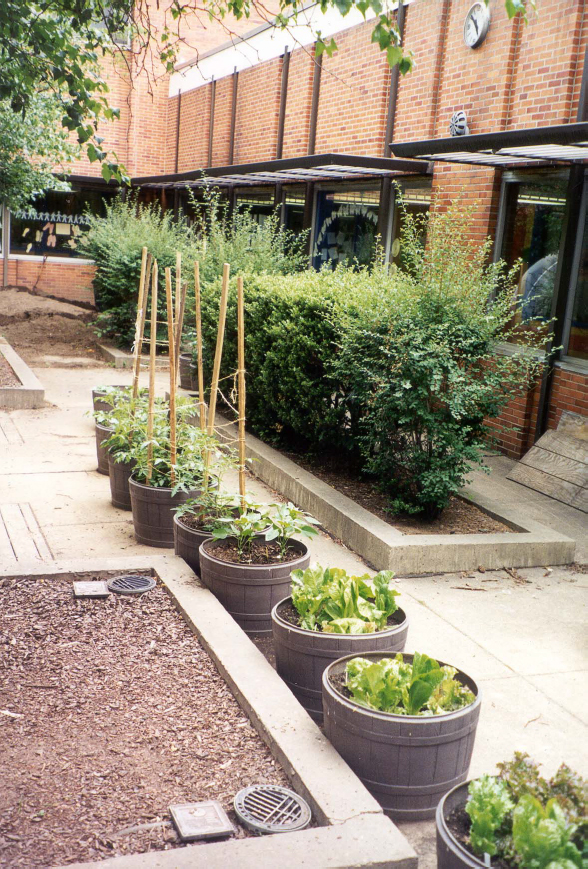Fact Sheet FS055

Photo Credit: James Nichnadowicz
Lack of garden space can be overcome by planting favorite vegetables, flowers, and herbs in containers. Seed companies now offer many kinds of vegetables which have a dwarf growth habit and are well adapted to growing in restricted space. Details on growing flowers in this manner can be found in FS1215 Outdoor Container Gardening with Flowering and Foliage Plants.
Select the Proper Variety
It is important to read the seed catalog variety descriptions carefully and to note the height of the plant. Generally, low-growing varieties are compact plants, but occasionally a variety which has a short-growth habit will have a spreading characteristic which makes it unsuitable for container growing. Certain vegetables, sweet corn and watermelons in particular, do not adapt to growing in containers. Another restriction is that dwarf vegetables, developed for extreme northern climates, often fail in the warmer New Jersey weather.
Some of the vegetables available in varieties adapted to container gardening include:
Many herbs grow well in containers including:
Do not overplant any one herb, unless your family is particularly fond of one type. Generally, a few plants of each herb will supply enough flavor for garnishing and cooking.
Specific dwarf varieties may be available from only one seed company. Consult several seed catalogs to choose vegetables best suited to container gardening.
Plants should be grown at the same spacing recommended for the garden. Large plants, such as eggplant or peppers, will probably grow best if given their own container. However, you can maximize your production by sprinkling a few seeds of a fast-maturing crop, such as lettuce or radish, around the edge of the container. You might also plant a small herb, such as basil or parsley, at the base of a taller, rangy tomato plant.
Select An Adequate Container
The kinds of containers available for growing vegetables are limited only by your imagination. Plastic or clay pots, buckets, baskets, and wooden boxes are suitable for most vegetables. Plastic tubs and garbage barrels provide space for roots of rank-growing vegetables, such as cucumbers and tomatoes. If solid plastic containers are to be used, drill ¼-inch holes along the sides and close to the bottom, but not in the bottom itself. This will provide drainage and prevent waterlogging of the root system. Stones or crushed rock should be placed in the bottom of the container to allow drainage of excess water. Permanent containers can be made by using cinder blocks, brick, or tile.
Soil or Synthetic Mix?
Although a good sandy loam will produce healthy plants, fewer problems will be encountered if containers are filled with a synthetic mix. This kind of plant growing medium is better aerated and does not pack as tightly as soil. Mixes are free of plant disease organisms and weed seeds that may be found in garden soil. A synthetic mix will hold moisture and plant nutrients well. Soils are two to three times heavier than plant mixes, which makes it difficult to move containers. Most garden supply centers have premixed synthetics. Soil mixtures can be prepared at home from horticultural-grade vermiculite, peat moss, limestone, superphosphate, and 5-10-5 fertilizer. For 1 bushel each of vermiculite and shredded peat moss, add 1 ½ cups of dolomitic limestone, ½ cup of 20% superphosphate, and 1 cup of 5- 10-5 fertilizer. All materials should then be mixed thoroughly.
Locations for Vegetables in Containers
Vegetables can be grown on patios, terraces, balconies, rooftops, or any other outdoor location, so long as they receive adequate light. Fruiting vegetables, such as tomatoes and peppers, require 8 hours of sunlight each day; root vegetables will need 6 hours of sun; and leafy vegetables will usually produce satisfactorily with only 4 hours of sunlight. Although sunlight is the most vital consideration in locating plants, it is also important to keep plants about 12 inches away from stone and masonry walls. Such walls tend to reflect too much heat for optimum growth.
Proper Care of Container-Grown Vegetables
The restricted volume of the container necessitates frequent watering, sometimes two or three times each day. Careful attention to fertilization is another cultural requirement. Because of the small amount of growing medium in the container, it is easy to overfertilize and cause damage to plants. Conversely, miscalculating the quantity of fertilizer can lead to insufficient fertilization for normal plant growth. A water-soluble fertilizer, such as 20-20-20, should be applied at the rate of ½ tablespoon per gallon of water once each week. Starting when plants are about one-half mature to when they attain full maturity, increase the rate to 1 full tablespoon of fertilizer per gallon once each week. Follow label directions for other ratios of fertilizer.
Insect and disease control should be practiced in the same manner that pest control is accomplished in a large outdoor garden. Essential information appears in the Extension fact sheets FS1124 Vegetable Disease Recommendations for Home Gardens and FS1123 Vegetable Insect Control Recommendations for Home Gardens. Most dwarf vegetable plants do not require special training, but if tomatoes or cucumbers become too large to stand upright, they can be staked or trellised.
October 2003
Copyright © 2024 Rutgers, The State University of New Jersey. All rights reserved.
For more information: njaes.rutgers.edu.
Cooperating Agencies: Rutgers, The State University of New Jersey, U.S. Department of Agriculture, and Boards of County Commissioners. Rutgers Cooperative Extension, a unit of the Rutgers New Jersey Agricultural Experiment Station, is an equal opportunity program provider and employer.

